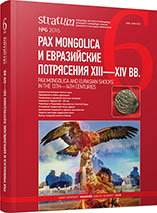Химический состав стекла Болгара и Сувара
Chemical Composition of the Glass from Bolgar and Suvar
Author(s): Svetlana I. ValiulinaSubject(s): History, Archaeology, Economic history, Middle Ages, 6th to 12th Centuries, 13th to 14th Centuries
Published by: Издательский дом Stratum, Университет «Высшая антропологическая школа»
Keywords: Bolgar; Suvar; 10th—14th centuries; Middle East; Central Asia; glassware; scanning electron microscopy; chemical composition; cross-cultural interaction
Summary/Abstract: The article presents the results of the analysis of a representative series of glass products from Bolgar, reflecting all the stages of the history of Bolgar (10th —15th centuries) and Suvar (10th —12th centuries). Scanning electron microscopy (SEM) was used as the main method. Excavation materials (mainly of recent years) made up an analytical sample. The article analyzes the most representative in both cities chemical type (sodium ash glass), which corresponds to Islamic glassmaking tradition, as well as the chemical composition of some special products from Bolgar, complementing broad international relations of Bolgar and the state of Volga Bulgaria. Data on the chemical composition of products (from the decorations of the Viking Age and early Islamic vessels to the Middle Eastern products with gold and enamel painting of the 13th —14th centuries and products of the glassmaking workshop in Bolgar), supported by historical interpretations and a wide range of parallels, allowed to identify the role of Bolgar and Suvar in the system of the medieval glassmaking. Priority was given to the materials of the Golden Horde period.
Journal: Stratum plus. Археология и культурная антропология
- Issue Year: 2016
- Issue No: 6
- Page Range: 337-353
- Page Count: 17
- Language: Russian
- Content File-PDF

